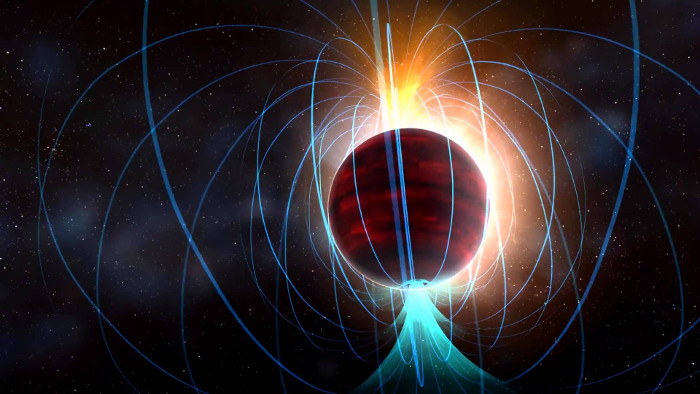The star is 10,000 times brighter than the Sun can prevent life from evolving
The tiny star that shines 10,000 times the Sun can hinder or disrupt the evolution of life on planets orbiting it.
The Space, the huge bursts of radiation from the star cause life to be difficult to evolve . If other stars of the same type glow so well, life in the universe has very little development.
The team led by Peter Williams at the Harvard-Smithsonia Center for Astrophysics (CfA) observes the star through the giant radio telescope Atacama Large Millimeter / Submillimeter Array (ALMA) in Chile.

The red dwarf has a magnetic field several times stronger than the Sun.(Photo: Harvard University).
Bright red dwarfs account for three-quarters of the celestial bodies in the galaxy. The star Williams's team has focused on is less than 1% of the Sun. It is 35 light years from Earth, in the constellation Boites.
Previous research on the star from Karl G. Jansky Very Large Array observatory in New Mexico indicates that a star with a magnetic field several times stronger than the Sun, despite the physical process that makes up the Sun's magnetic field unlikely on such a small star.
Williams and his colleagues directed the focus of ALMA to the star and for the first time discovered the red dwarf glowing regularly. The light emitted is 10,000 times brighter than the Sun. The discovery was published in the Astrophysical Journal on November 17.
In order to store liquid water on the surface, conditions necessary for life to evolve, a planet orbiting a glowing red dwarf must be located near its parent star. But this close distance puts the planet at risk of being affected by fire storms or charged molecular outbursts. The solar wind also helps to blow away charged molecules toward the planet.
If radiation from mother stars reaches the surface of the planet, it can destroy all forms of life that are growing. The Earth has a thick atmosphere that can block most of the radiation, but if the planet's orbit is too close to a red dwarf, fire can penetrate every protective layer.
"Like the Hurricane Corridor in the US, the location of your life puts you at greater risk of typhoons. The planet is located in an area where life of this star may be subject to storms much stronger than storms. Born from the Sun, " Williams said.
- The star is brighter than the Sun.
- Photo of the universe: The star is 150 times brighter than the Sun.
- The supernova is 20 times brighter than the Milky Way
- Detecting star clusters 30 million times brighter than the Sun.
- The star is 20 million times brighter than the sun
- The formation of the star is 300 times brighter than the Sun.
- Detect extremely bright stars in the sky
- The painful death of a star ripped apart by a supermassive black hole
- The scientific world is confused because the
- Comet is brighter than the full moon visiting Earth in 2013
- Discovering 'green spots' in the universe
- RCW103: The star and the mysterious friend?
 Van Allen's belt and evidence that the Apollo 11 mission to the Moon was myth
Van Allen's belt and evidence that the Apollo 11 mission to the Moon was myth The levels of civilization in the universe (Kardashev scale)
The levels of civilization in the universe (Kardashev scale) Today Mars, the sun and the Earth are aligned
Today Mars, the sun and the Earth are aligned The Amazon owner announced a secret plan to build a space base for thousands of people
The Amazon owner announced a secret plan to build a space base for thousands of people A shooting star, about to explode in the sky of Earth?
A shooting star, about to explode in the sky of Earth?  Image of a new star spewing gas loudly across the Milky Way galaxy
Image of a new star spewing gas loudly across the Milky Way galaxy  The 'deadly' truth about strange radio signals transmitted to Earth
The 'deadly' truth about strange radio signals transmitted to Earth  Scientists Stunned to Discover Star With Supersonic Tsunamis Three Times Higher Than the Sun
Scientists Stunned to Discover Star With Supersonic Tsunamis Three Times Higher Than the Sun  Death 11.5 Billion Years Ago Bombs NASA: A Chilling Prediction for Us
Death 11.5 Billion Years Ago Bombs NASA: A Chilling Prediction for Us  In 2024, the cosmic monster in the 13th century ancient text will return.
In 2024, the cosmic monster in the 13th century ancient text will return. 